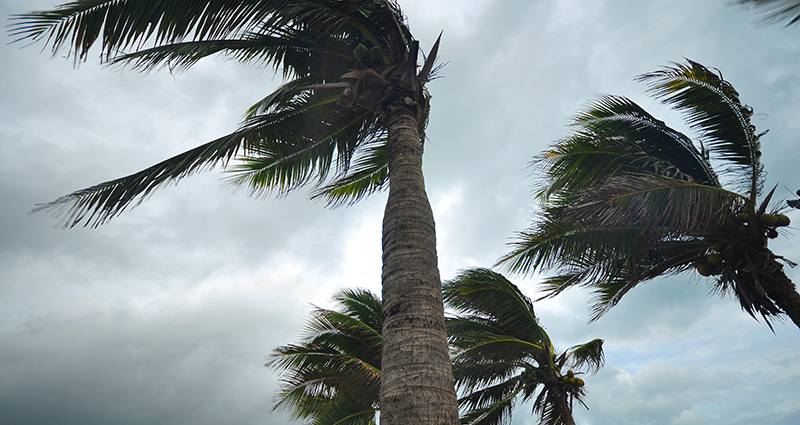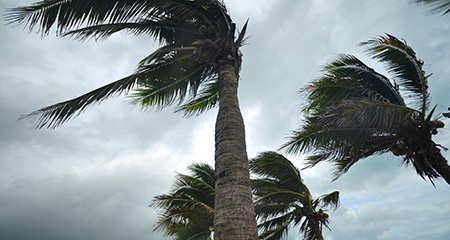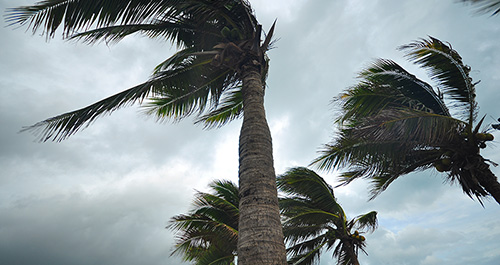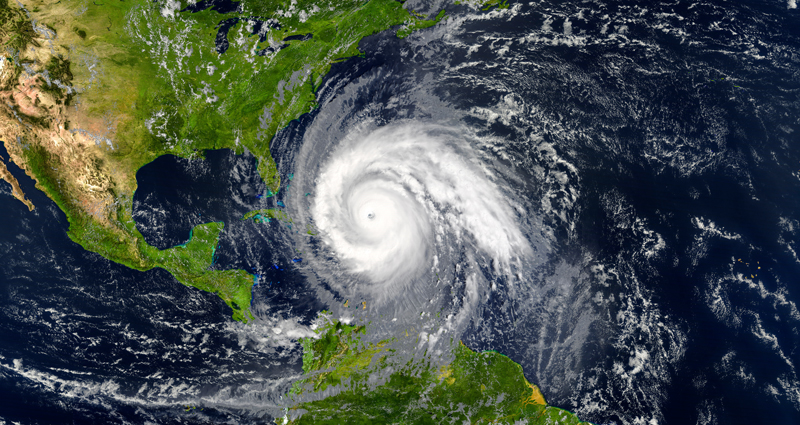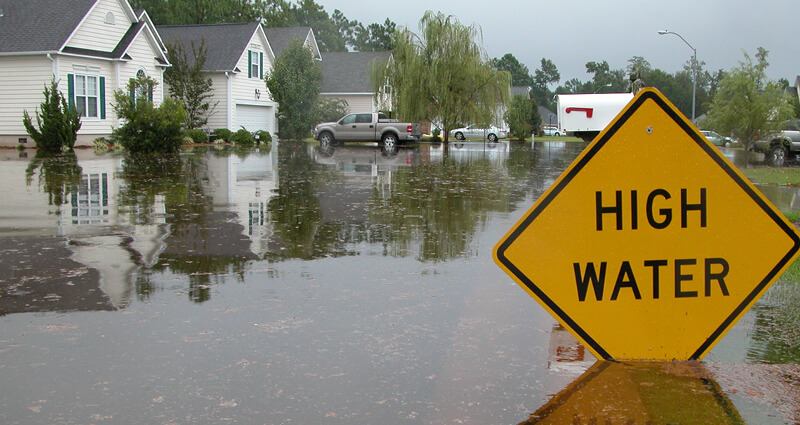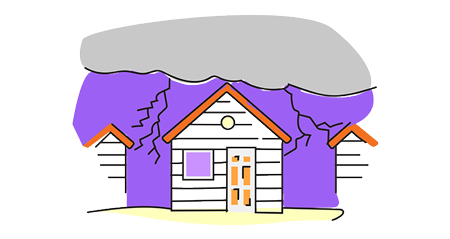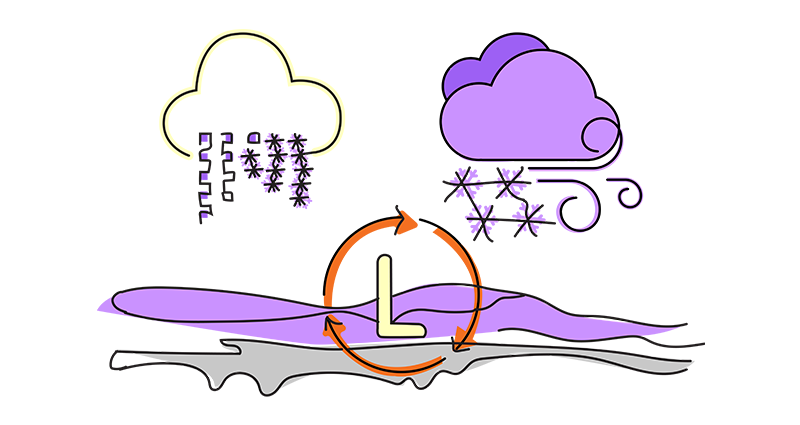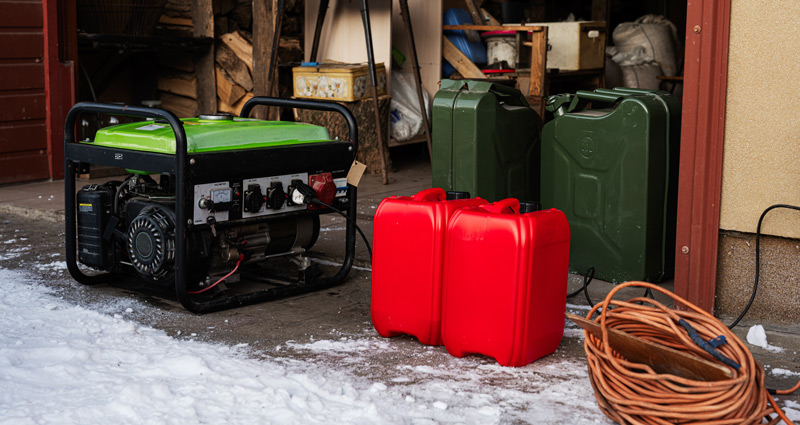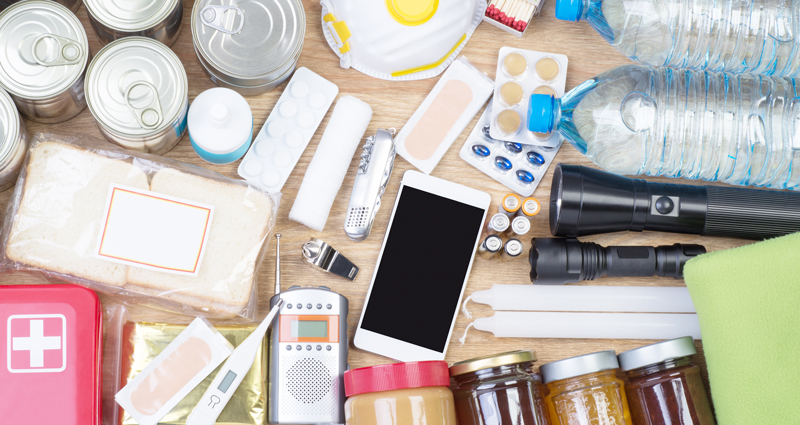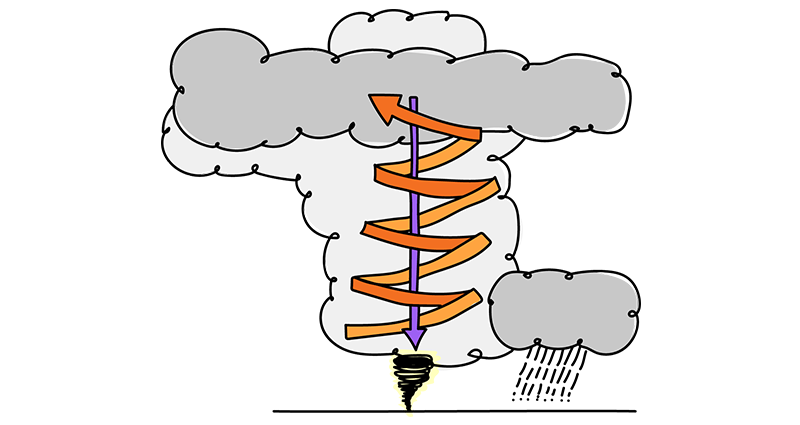Causes of high winds and storms
We expect high winds during stormy weather or more intense storms like tropical storms and hurricanes. But dangerously high winds can occur even on a clear day because the causes of windstorms all come down to temperature.
Gas particles bundle tightly together in cold air and spread out as the air warms, which is why you may hear masses of cold and warm air referred to as “high-pressure systems” and “low-pressure systems,” respectively. When these systems collide, air rushes from the high-pressure area to the low-pressure area, creating wind. The greater the pressure difference, the faster the wind.
Heavy winds are typically formed by atmospheric pressure variations, which cause gusts of air to rush in to fill low-pressure zones. Additionally, wind can result from heavy activity in the jet stream high in the sky. Finally, large fronts of cold air can also provoke turbulence in the atmosphere. When all those conditions combine, you could be in for winds that endure for days.
While wind is a frequent and usually benign natural phenomenon, the effects of windstorms do have the potential to cause harm to you and your home, either on their own or in conjunction with other weather conditions. Read on for tips on how to prepare for a major windstorm and what to do if one does arrive in your town.
Understanding wind alerts
The National Weather Service issues a range of wind alerts when high winds are predicted or occurring. Because some areas of the U.S. are naturally windier than others, these warnings may be triggered at different wind speed levels in one place than in another. Every National Weather Service forecasting office has its own regional criteria for wind alerts.
These alerts include:
- High wind watch - Strong, sustained winds are possible
- High wind warning - Strong, sustained winds with stronger gusts are occurring
- Wind advisory - Same as a high wind warning, but with slower wind speeds
- Severe thunderstorm watch - A severe thunderstorm capable of producing 58 mph winds or faster is possible
- Severe thunderstorm warning - A severe thunderstorm capable of producing 58 mph winds or faster is occurring or imminent
- Hurricane force wind/gale warnings - Issued in coastal regions when high winds are predicted
- Dust storm warning - Issued when visibility is reduced to ½ mile or less due to blowing dust or sand from sustained or gusting winds
For smartphone users, the easiest way to keep tabs on all severe weather alerts is to download a weather app that offers alert notifications.
High winds safety
Property is replaceable, but there’s only one you. When there’s no time to batten down the hatches, the most important thing is to make sure you and your family are safe until the winds die down.
- Get indoors, if possible, when high winds are occurring. Stay away from windows, and if winds are severe or if tornadoes are possible, move to the basement or the lowest interior room. Manufactured homes and trailers are not safe shelters in high winds.
- If you’re stuck outside in high winds, seek the safest shelter possible. This could be next to a building or in an exterior below-ground stairwell. You want to protect yourself from flying debris or from being blown into more dangerous areas, like roads or train tracks. During extreme high winds or tornadoes, the safest place in an open area may be face-down in a ditch or low-lying ground, with your hands clasped behind your head.
- If you’re driving during high winds, reduce your speed and keep plenty of room between your car and others. It’s especially important to drive with caution in high winds if you’re driving a high-profile vehicle or if you’re towing a trailer. If the wind makes driving difficult, consider pulling onto the shoulder or into a parking lot and remaining in your vehicle while you wait for the wind to diminish.
- If you see downed power lines, call your local electrical utility. You can also report downed lines to your local police. Do not go near downed lines or utility poles. Downed lines can electrify puddles and even moisture in the ground, so you should remain indoors if lines fall near your home.
Preparing your home for high winds
The damaging effects of windstorms can range from broken flowerpots to having your roof torn off. Here are some ways you can protect your property:
When high winds are predicted or imminent:
- Bring pets and children indoors.
- Secure loose items like toys, lawn furniture, trash cans, garden decorations and small potted plants by moving them to a shed or garage.
- Park your vehicles in a garage if the space is available.
- If there are large items outside your home that you can’t move indoors, secure them as needed with tie-downs or sandbags.
- Close and latch storm shutters if they’re already installed.
- Close and latch all doors and windows.
Plan ahead to avoid wind damage:
- Trim your tree branches, especially in cases of dead limbs or limbs that could bring down power lines or crash through windows.
- Install storm shutters or other semi-permanent wind protection. If you’re bracing for a tropical storm or hurricane, you may have sufficient warning time to board up your windows with plywood.
- Schedule a professional roof inspection. An annual inspection can help you fix small things like loose shingles before wind or rain can turn them into major problems.
- Check your seals and insulation. Seal the cracks around windows and doors and check that your home’s insulation is up to par. On high-wind days, drafts can blow through old, cracked weather stripping and make your home feel chilly.
- Keep your yard clear of loose objects and debris that could be turned into projectiles by a stray gust.
- Prepare an emergency kit. High winds are a major cause of blackouts, so keep an emergency kit handy with everything you need to spend hours or days without electricity. If trees come down on the roads, you could be forced to survive on the food and water you have around your house, so make sure you maintain an ample stash.
Understanding wind chills
A nice breeze is a welcome arrival on a stifling summer day, but when the thermometer drops in the winter months, wind can contribute to uncomfortable and possibly dangerous conditions. That’s because high winds provoke chills by causing you to lose body heat at a much faster rate than you would normally expect at a given temperature in non-windy conditions. This effect works primarily through convection when the warmth is transferred out of your body and onto the fast-moving air molecules. You’ve probably heard of the wind chill factor – when it feels much colder outside than the thermometer would have you believe.
For example, according to the National Oceanic and Atmospheric Administration, on a 30° day, just 5 mph of wind can make it feel like 25° out. If that wind picks up to 30 mph, it will feel like 15°, a considerably chillier experience. The colder the actual temperature, the more acute the wind chill effect, which at extreme levels can lead to frostbite and other medical emergencies like hypothermia. If you have to venture outside, make sure you know what to do during wind chills.
What to do during wind chills
- Stay dry. Wet clothing can cause much faster heat loss. Wear insulated and waterproof boots when it’s snowy or rainy.
- Dress in layers. Layers of loose-fitting clothing help to insulate. Wear a hat and gloves.
- Stay informed. Don’t forget to take wind into account when calculating just how bundled up you need to be.
Wind and storms
Wind can cause plenty of damage on its own, but it often arrives hand-in-hand with other forms of nasty weather that can compound the danger. Straight-line wind that precedes a thunderstorm is known as a derecho and can create considerable chaos even before heavy rains and lightning bolts arrive on the scene.
If the windstorm comes in wintertime and is accompanied by heavy snowfall that limits visibility, it’s likely to be classified as a blizzard, which carries its own set of precautions you should take to ensure the safety and security of your home and family.
Depending on where you live, you may be subject to extreme wind-related weather events such as hurricanes or tornadoes, which are life-threatening occurrences that may require more intense emergency preparation up to and including evacuation. Please follow all instructions from local officials if you are unfortunate enough to experience such a disaster and make the safety of your family your number one priority.
High winds and wildfire are also a deadly combination, as the massive conflagrations that have overrun large swaths of the western United States the past few years have demonstrated. If you find yourself in the path of an uncontrolled wildfire, again, it’s imperative to vacate the area immediately and follow the guidance of the appropriate authority figures.























